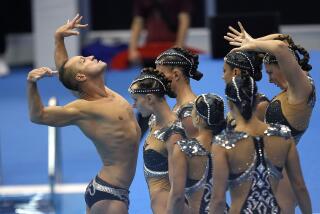From Mission to Mission, Coast to Coast : Mission Bay Makos Making a Big Splash With Shubert, O’Brien
BOCA RATON, Fla. — Diving Coach Ron O’Brien staggered into the plush temporary offices of the Mission Bay Makos Aquatics Club under a pleasantly heavy load.
The hefty cardboard boxes in O’Brien’s arms contained some of the first evidence of Makos on the move--women’s and combined team trophies from last week’s national diving championships in Indianapolis.
Mission Bay’s unprecedented sweep at the diving nationals, along with the Makos’ fifth-place finish at the short course nationals in March, is rapidly putting the Boca Raton neighborhood on the national map.
A year ago, there was no team named after the blue mako shark, which races and leaps through the waters off Florida’s coast.
But by the time the 1988 Olympics begin, the nation may be familiar with thenew breed of Makos from Mission Bay, as it once became familiar with the Mission Viejo Nadadores.
After the 1976 Olympics, you didn’t need a medal detector to identify such Nadadores as Shirley Babashoff and Brian Goodell, the first in a chain of Mission Viejo champions.
The Makos have several things in common with the early Nadadores, starting with their coaches, Mark Schubert and O’Brien, formerly of Mission Viejo. With a number of other ex-Nadadore staffers, swimmers and divers, the Makos have the potential to make an equally big splash.
The strange part is, no such place as Mission Bay actually exists, yet. You might want to check back in July when the dust settles around the man-made lakes seven miles west of Boca Raton.
The aquatics teams representing Mission Bay have jumped out of the starting blocks before developers had time to erect the first house.
Not to mention finish any of the five pools. The teams are training at such places as a high school, a university and a country club, but nobody in Boca Raton has a pool as large as either of the two monsters under construction at Mission Bay.
“Considering that it doesn’t have a single house built on it yet, Mission Bay is probably the best-known place in the United States,” said developer James Brady, the man behind the $250 million project.
The way the homeless Makos are going, the next thing Brady should plan to build at Mission Bay is a trophy case. This might be the perfect time to set aside a vacant acre or two for that purpose.
Most eight-month old aquatics teams would be lucky to win their first meet against the junior splashers from the subdivision down the road.
To beat many of the country’s best senior teams when your home pools are still holes in the ground is the sort of thing perhaps only a Schubert or O’Brien could pull off.
Certainly, skeptics in the swimming world doubted that even these former Olympic coaches would succeed so soon after their transcontinental transplant.
Only last summer, Brady lured them from Mission Viejo with the promise of a $5 million space-age swimming complex to rival any in the world, plus a staff and salaries on a proportionately grand scale.
A physiologist, sports psychologist, nutritionist, sports medicine lab, weight rooms, press box and permanent stadium seating for 4,500 . . . it was a swim coach’s pipe dream--Schubert’s, to be exact--brought to reality.
Brady, 47, has a reputation as a person who likes to do things first class, and he has the financial clout to support his desires.
When he entered the market for swimming and diving coaches for his project, which is a “family-themed village” in a retirement-oriented state, he wound up getting arguably the best duo in the business.
“For me, it was a dream come true to have the chance to hire these coaches,” Brady said. “They gave us instant credibility.
“I could have built the Taj Majal and without the staff, it would mean nothing.”
Brady is enthusiastic about aquatics and is clearly enjoying his role as benefactor. When Greg Louganis gave Brady one of his diving medals at the nationals, the multimillionaire carried it around for days.
“I couldn’t own the Dolphins because Joe Robbie’s got them already,” Brady said. “But frankly, I think I may be getting more enjoyment out of this than Joe gets out of the Dolphins.”
But Brady is up front about the business advantages of associating his housing community with a high-profile, world-class sports club.
“I admit I’m using the Mission Bay Makos as a public relations focus for this community,” Brady said. “But I’m not going to sell 1,500 homes to swimmers.
“It’s a source of pride to live in a community with a program like the one in Mission Viejo or Mission Bay.
“You’d turn on the TV, and there were Mark and Ron and the Mission Viejo Nadadores, and I’m sure the people who lived in Mission Viejo were proud of that.”
Brady implies that Phillip Morris, the company that developed Mission Viejo, didn’t recognize the gems it had in Schubert and O’Brien.
On a trip to tour Mission Viejo, Brady was surprised to learn the coaches weren’t even protected by long-term contracts.
No one will disclose Schubert and O’Brien’s new salaries, but neither can anyone deny that they probably are the country’s the best-paid aquatics coaches.
“You don’t pay Don Shula $10 to coach the Miami Dolphins and you don’t pay Mark Schubert and Ron O’Brien $10 to coach the Mission Bay Makos,” Brady said, adding that the coaches also are stockholders in the aquatics complex, which is projected to operate for profit.
Even so, Schubert and O’Brien were taking a giant step into the unknown in accepting the Mission Bay jobs.
To hope that Mission Bay might exceed what they accomplished at Mission Viejo could seem like Mission Impossible.
In 13 years, Schubert guided the Nadadores to 19 Olympic medals and 45 national team titles, the most wins ever by any swim club.
O’Brien, a five-time Olympic coach, coached Nadadores divers to six Olympic medals in 1984 and 35 national team titles.
In moving 2,600 miles to try to transform a former Florida dairy farm into a world-class aquatics center, the first signs of success could have been years, not months, down the road.
“One week I’m coaching 55 kids and half of them are thinking about senior nationals,” said Larry Liebowitz, the first to accept a coaching position with the Makos. “The next week I’m working with a group of six swimmers who are not extremely skilled. There were some bad days.”
But the timetable surged forward when many of Nadadores executed a big leap of faith and decided to come to the Southeast.
“Never in my wildest dreams did I imagine I’d come to Florida,” said Michele Mitchell, an ex-Nadadore diver and Olympic silver medalist. “I’m very West Coast. It’s where I’ve spent all my life.
“When Ron said he was moving to Florida, I said, ‘You’re what ?’ ”
But in the end, she broke the lease on her El Toro condominium and relocated.
“It was across the country from everything I’d known,” said Mitchell, who tied with teammate Wendy Wyland for the high-point award at last week’s national championships. “I really gave it a lot of thought.
“At first, I wasn’t sure if I was going to continue training until ’88. Then I decided it would behoove me to continue on the path of success Ron had established for me . . . and here I am in Florida.”
Nearly all of O’Brien’s divers, 13 of the 15 seniors, followed him from Mission Viejo to Florida, along with about 15 of Schubert’s best swimmers.
Among the divers who have joined the Makos are two-time gold medalist Greg Louganis, bronze-medalist Wendy Wyland, national age-group champion Wendy Williams, national champions Kent Ferguson and Wendy Lynn Lucero, as well as Jim Gray and Scott Donie.
“There’s a serious amount of trust going on here (in the decisions to relocate),” Mitchell said. “People have a lot of faith in these coaches.”
She said the decision was made more difficult by the fact that 1986 is a world championship year, so the disruption in training could be extra costly.
“I think people thought we were nuts--and at moments, so did I,” Mitchell said. “I think we felt we had a lot to prove (at nationals) to show that everything was OK out here.
“A lot of opposing teams were real skeptical (of the wisdom of the move), and I think they thought this would be the year (to knock off O’Brien’s team). But everyone pulled together real well.
“We had no team titles, no individual wins representing Mission Bay. We had no history. We had to write some history.”
O’Brien said: “I told them at the beginning of the year that this would be character-building time. I told them the facilities don’t make the team, people do. And if you have the right people, they would be able to overcome it.”
The Makos swim team has drawn national breaststroke champion Susan Johnson, Olympic silver-medalist backstroker Amy White, and champions from around the world, such as Nina Herbert of Britain, Yoshiyuki Mizumoto of Japan, Isabelle Weibel of Switzerland and Benny Neilsen of Denmark.
When the college terms end, the Makos ranks will be swelled by Olympic swimmers Tiffany Cohen, Mike O’Brien and Dara Torres.
“They’re training specifically with Mark,” Mitchell said of the college-aged swimmers. “He could be in Timbuktu and they’d still follow him.”
Both Schubert and O’Brien agree it was difficult to leave Mission Viejo, and they still miss the friends and athletes they left behind.
“You want to talk about heart-tugging time, that was at the U.S. Open Meet when I saw the Mission Viejo team walk in,” Shubert said. “It was the first realization that I wasn’t a part of that anymore.
“Since we (the Makos) weren’t in it, there wasn’t any doubt who I was rooting for to win the men’s team title.”
At the same time, neither Schubert nor O’Brien regrets his decision. The new complex will allow each to double the size of his team--Schubert envisions his dream of developing crops of swimmers “from womb to tomb.”
With the aquatics complex approaching completion, the worst part of the pioneering year is behind them. They are eager to leave the fancy offices in town and move into temporary trailers on the pool deck.
When they need inspiration, they drop by the site to watch the tractors and cranes at work.
This happens about every other day. Schubert races around the site like a kid on Christmas morning.
“Hey, Larry,” he exclaimed to Liebowitz, “look at these floats!” He examined the pool bulkheads, with a wide smile. He waved a hand across the expanse of pools under construction with the air of a Texas rancher surveying his domain.
“We’ve got the capacity for 54 short courses (at once),” Schubert said. “At five kids per lane, that’s 270 kids (training in one shift). I’d call that pretty comfortable.”
More to Read
Go beyond the scoreboard
Get the latest on L.A.'s teams in the daily Sports Report newsletter.
You may occasionally receive promotional content from the Los Angeles Times.






